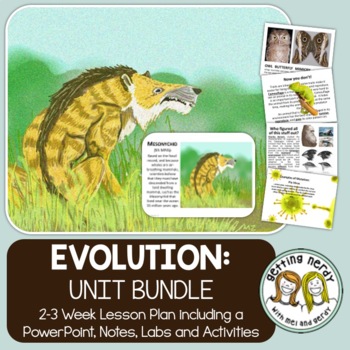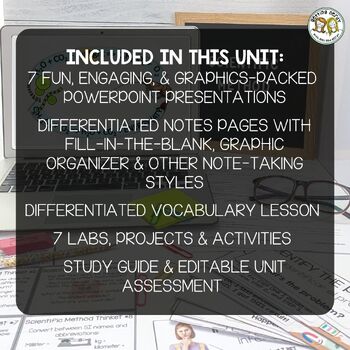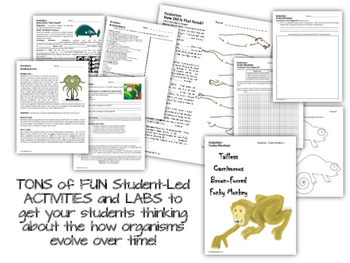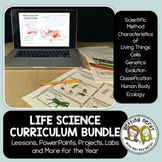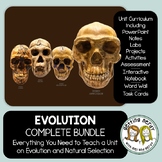Evolution, Natural Selection, Adaptation - PowerPoint & Handouts Bundle
- Zip
What educators are saying
Also included in
- Everything you need at your fingertips! Teach an entire YEAR of life science with over 35 weeks of lessons in this curriculum bundle - including daily warm-ups, lessons, labs, activities, projects, study guides and assessments, and an animated PowerPoint for each of the following units: Scientific MPrice $399.95Original Price $537.15Save $137.20
- Unit Lesson Plans complete with guiding PowerPoint and student pages? ✓Word walls? ✓ Interactive Notebooks? ✓Task Cards? ✓You're ready to teach with this comprehensive bundle for teaching Evolution. Engage your students with our animated PowerPoints and aligned lessons, 15+ Interactive Notebook actiPrice $57.95Original Price $68.85Save $10.90
Description
Watch evolution in action as you leave your species' fate up to chance playing our funky monkey game and trace the evolution of the whale from land to sea in our evolution unit bundle complete with a guiding PowerPoint, tons of activities, graphic organizers and more.
WHAT'S INCLUDED in this 2-3 WEEK LONG BUNDLE:
• 100+ slide fully editable PowerPoint presentation with title slides, objectives, bell work, guided notes, and animations along with 50+ NON-EDITABLE PDF pages which includes aligned notes, labs, projects, activities, study guide and assessments covering the following topics:
→ Theory of evolution
→ Mutation and adaptation
→ Charles Darwin and his theory of evolution by natural selection
→ The Industrial Revolution
→ Evidence of evolution
→ Types of camouflage
→ Radioactive dating
TO ACCESS THE MATERIALS NEEDED FOR THIS UNIT, CLICK HERE.
STUDENTS WILL:
• Follow along with the PowerPoint as they complete the aligned lessons, activities, projects and labs
THIS PRODUCT IS ALSO FOUND IN OUR:
• Evolution Complete Bundle - PowerPoint Unit, INB, Task Cards, Word Wall
• Life Science Biology Curriculum Bundle
CHECK OUT OUR OTHER EVOLUTION PRODUCTS:
• Evolution, Natural Selection & Adaptation - Interactive Notebook Activity Pack
• Evolution Bundle - STEAM Science Centers / Lab Stations
• Adaptations Thanksgiving Activity for Evolution
SEE HOW THIS LESSON ALIGNS WITH THE NGSS, TEKS or GSE
Because we have created many of our own graphics or have purchased licenses to other graphics with permission, we cannot offer our resources in editable format unless otherwise stated.
TERMS OF USE (TOU):
All rights reserved by GETTING NERDY®️
• This product is to be used by the original purchaser only
• Intended for classroom and personal use only
• Copying for more than one teacher, classroom, department, school, or school system is prohibited
• This product may not be distributed or displayed digitally for public view
Failure to comply is a copyright infringement and a violation of the Digital Millennium Copyright Act (DMCA). Clipart and elements found in this PDF are copyrighted and cannot be extracted and used outside of this file without permission or license.
Evolution - PowerPoint and Handouts © 2012 to present Getting Nerdy ®️ All Rights Reserved
www.gettingnerdyscience.com

